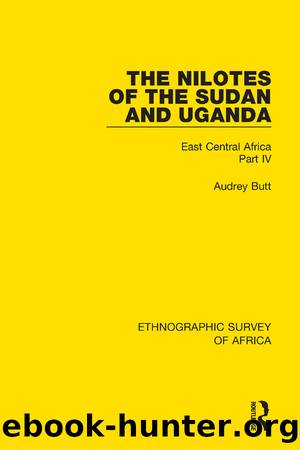The Nilotes of the Sudan and Uganda by Audrey Butt

Author:Audrey Butt [Butt, Audrey]
Language: eng
Format: epub
ISBN: 9781138232006
Barnesnoble:
Publisher: Taylor & Francis
Published: 2019-01-08T00:00:00+00:00
INTER-VILLAGE WAR AND FEUD
According to Driberg, who is supported to some extent by Hayley, the Lango were almost continually at war among themselves during the period before the British administration. Driberg describes the organisation as âessentially militaryâ.(1)
In wars against other tribes, clubs, spears and shields were used in fighting. In feuds between Lango villages a different method was practised. If feeling between villages over some dispute was such that there was no basis for mediation by the elders, a whipping duel was held. A tree was cut down and the branches were lopped off. The warriors of each village drew up in a line on each side of the tree, armed with lashes 8 feet long, and they would whip each other across the tree until an umpire, standing at one end, judged that enough punishment had been given and taken and that feelings on both sides were sufficiently relieved. Skill in wielding the whip was admired and no spears were allowed to be brought.(2)
Driberg maintains that it was largely as a result of participation in the wars of the Bunyoro with the Buganda that the Lango began to fight among themselves in a more violent manner than the duel described above.(3) According to him there was a perpetual state of war and no one was safe outside his village. Although inter-village relations appear to have been particularly hostile about that time, it would seem that Driberg exaggerated. Certain factors made for a degree of village co-operation and some of these factors are mentioned by Driberg himself in his accounts.
1. âLineages of the same clan were spread over a number of villages and this must have mitigated feuds to a certain extent.
2. âThe age-se t system and rain-making ceremonies were on an inter-vi liage basis in three of the four divisions of the Lango.
3. âCo-operation for hunting occurred, several villages taking part in a hunt in a large arum.
4. âThere was the practice of placing cattle in the kraals of other villages to avoid a whole herd being destroyed by rinderpest and perhaps to express friendship or kinship.
5. âA number of neighbouring villages would recognise a rwot and the powerful lineage in the district which he represented. A number of villages would unite under the rwot for war, and in times of particular hostility they would unite under a twon lwak.
It therefore seems that the villages, though structurally differentiated and opposed to each other to a certain extent, were loosely organised into associations for defensive and offensive purposes. These associations were, no doubt, of the vaguest type, and perhaps only temporary, and they appear to have entailed few legal or political consequences.
Download
This site does not store any files on its server. We only index and link to content provided by other sites. Please contact the content providers to delete copyright contents if any and email us, we'll remove relevant links or contents immediately.
| Historic | Information Systems |
| Regional |
Man-made Catastrophes and Risk Information Concealment by Dmitry Chernov & Didier Sornette(5956)
The Revenge of Geography: What the Map Tells Us About Coming Conflicts and the Battle Against Fate by Kaplan Robert D(4052)
Zero Waste Home by Bea Johnson(3805)
COSMOS by Carl Sagan(3589)
Good by S. Walden(3521)
In a Sunburned Country by Bill Bryson(3508)
The Fate of Rome: Climate, Disease, and the End of an Empire (The Princeton History of the Ancient World) by Kyle Harper(3032)
A Wilder Time by William E. Glassley(2835)
Camino Island by John Grisham(2778)
Organic Mushroom Farming and Mycoremediation by Tradd Cotter(2661)
The Ogre by Doug Scott(2657)
Human Dynamics Research in Smart and Connected Communities by Shih-Lung Shaw & Daniel Sui(2479)
Energy Myths and Realities by Vaclav Smil(2463)
The Traveler's Gift by Andy Andrews(2436)
9781803241661-PYTHON FOR ARCGIS PRO by Unknown(2343)
Inside the Middle East by Avi Melamed(2326)
Birds of New Guinea by Pratt Thane K.; Beehler Bruce M.; Anderton John C(2236)
A History of Warfare by John Keegan(2214)
And the Band Played On by Randy Shilts(2166)
